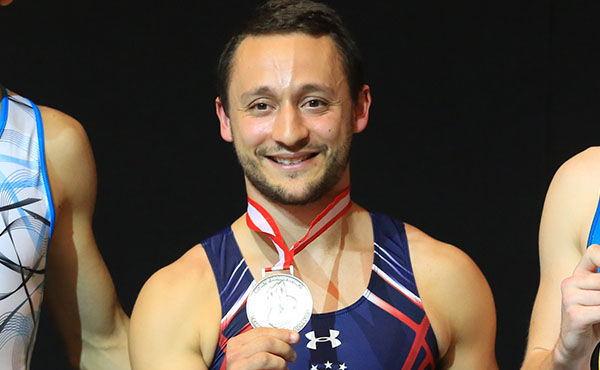
Austin White had been there before – quite literally. As he stepped up to the end of the runway during the men’s double mini-trampoline final at the 2015 World Championships in Odense, Denmark, he knew his fifth appearance in the final would be his last.
His next opportunity would be the 2017 Worlds, a wait too long at 27 and one he had experienced twice before. White had already watched the clock tick by through the Olympic years in 2008 and 2012 when there is no global meet for double-mini, patiently waiting for a return trip to the Worlds. But not this time.
After silver medals in three previous Worlds (2010, 2011 and 2014), he knew this would be his final chance for an elusive individual gold.
“In that moment, there can be a ton of emotion, a ton of thought. And, you know, it’s easy for people to look at that and think, ‘You must have panicked,’” White said. “But after having competed so many times, I analyzed the situation before I went out, and I made a conscious decision to kind of flip that accelerated emotion where I could have led it toward panic, and, ‘Oh my God, this my last chance, this is my last time.’
“‘This could blow up in my face,’ I thought that for one second, but the rest of the time, I was completely focused on the opposite: that this could be one of the best moments of my life,” said White.
That moment was just one in a journey that started at age 13 for White – perhaps years after his peers had taken up the sport. It was a journey filled with highs and lows. Highs like making his first World Championships team in 2006, winning his first World team medal in 2009, and the ultimate high, helping the USA to the men’s double-mini team gold in 2013.
“Winning with the 2013 team gold was one of my ultimate goals and dreams,” said White. “I love competing with other people. Being able to count on my team and not just myself is big to me.”
But there were lows, too. Like hamstring injuries that kept him out of the 2007 Worlds and affected his performance at the 2010 meet. After an excruciating two-year wait, a botched pass in 2013 that kept the then reigning World silver medalist out of the final. And the frustration of coming devastatingly close – as close as .400 in 2010 – to being an individual World champion.
These instances, the near misses for the gold, he believes, set up the rest of his career by creating a philosophy of “stay motivated and never give up,” said White.
With retirement looming, White stood at the end of that runway in Denmark with one last shot at individual gold.
“Coming from three silvers, my problem has never been performing,” White said. “It’s been performing consistently over two passes.
“My focus was to get out there and earn as many points as possible on that first run,” White added.
With just a small step on his first pass – a tucked Triffus to triple back tuck – he watched as a 38.100 flashed on the scoreboard.
“Once I saw that,” said White, “then, I knew that I was set up to eventually win. I knew that’s what I needed.”
A bold prediction given that his second pass, a piked Triffus to a half-in piked Triffus, was so difficult, White can describe in detail each time he has performed the pass. It’s a pass so hard he admits he needs the energy of a high-stakes competition to pull it off, having rarely performed it in workout. That’s a practice he doesn’t endorse as he begins his post-competitive gymnastics life as a coach, as well as the trampoline Athlete Representative for USA Gymnastics.
“As I looked at the runway and looked at the double mini, I channeled all of that emotion and energy and put everything I had into that second pass, and you can see it in my face in the end,” White said.
He had performed the pass nearly flawlessly, sticking the landing with a laugh as if to say, “How’d I do that?” In that instant, he knew he had finally done it.
“That was just pure joy.”




